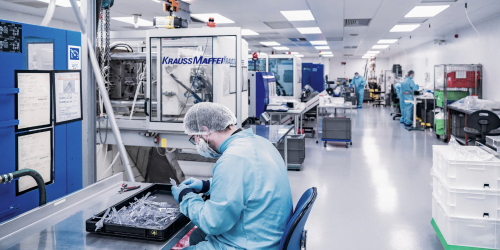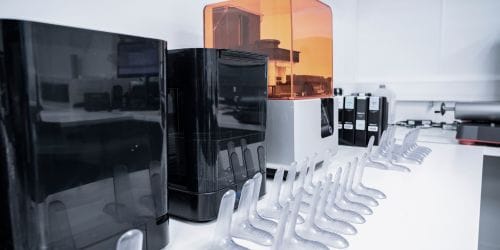Injection moulding is one of the most widely used manufacturing processes for creating plastic parts and products. Its versatility allows for the production of complex shapes with high precision, making it ideal for mass production.
However, designing for injection moulding involves specific considerations to ensure the efficiency and quality of the final product. This blog will walk you through the essential design considerations for injection moulding, providing a comprehensive guide to help engineers and designers optimise their designs for this manufacturing process.
Introduction to Injection Moulding
Injection moulding involves injecting molten plastic into a mould cavity, where it cools and solidifies into the desired shape. The process is used in various industries, including medical devices, automotive, consumer electronics, and packaging, due to its ability to create complex parts with tight tolerances.
However, the success of injection moulding relies heavily on the design of the part, the mould, and the process itself. A poor design can lead to defects like warping, sink marks, and even complete failure of the moulded part. Therefore, understanding the design principles behind injection moulding is crucial for ensuring that parts are functional, cost-effective, and manufacturable.
Key Design Considerations for Injection Moulding
1. Material Selection
The choice of material is one of the most critical decisions in the design process. Different plastics have distinct properties such as shrinkage rates, thermal stability, mechanical strength, and chemical resistance. Thermoplastics like polyethylene, polypropylene, and ABS are commonly used in injection moulding due to their ease of melting and reprocessing. The selected material should align with the functional requirements of the part, including its strength, flexibility, and environmental resistance.
2. Wall Thickness
Maintaining uniform wall thickness is vital for preventing defects such as warping, sink marks, and excessive material consumption. Variations in wall thickness can cause uneven cooling, leading to internal stresses and part deformation. Ideally, walls should be as thin as possible while still providing the necessary strength. This not only reduces material usage but also shortens cycle times and improves cost-efficiency.
3. Draft Angles
Draft angles are tapered surfaces on the walls of the moulded part that allow for easy ejection from the mould. Without proper draft, parts may stick to the mould, causing surface defects or requiring excessive force to remove, which can damage the part. A typical draft angle ranges from 1 to 2 degrees, but more complex designs may require greater angles.
4. Ribs and Bosses
Adding ribs and bosses to a design can improve the strength of the part without significantly increasing the wall thickness. Ribs provide structural support, preventing warping and buckling, while bosses are used to facilitate assembly by providing a location for screws or other fasteners. However, these features should be carefully designed to avoid creating thick areas that may lead to sink marks.
5. Undercuts
Undercuts are recesses or protrusions that make it difficult to eject the part from the mould. While undercuts can add functional or aesthetic value, they complicate the mould design and increase production costs. Wherever possible, undercuts should be minimised or designed in a way that allows for moulding without complex side actions or sliding cores.
6. Gate Location and Type
The gate is the point where molten plastic enters the mould cavity. The location and type of gate significantly affect how the material flows, how the part cools, and the appearance of the finished part. Ideally, gates should be placed in areas that allow for uniform flow and prevent issues such as air traps or weld lines. Common gate types include edge gates, pinpoint gates, and tunnel gates, each with its own set of advantages based on part geometry.
7. Shrinkage and Tolerances
All plastics shrink as they cool, and different materials shrink at different rates. Designers must account for this shrinkage to ensure the part’s final dimensions are accurate. In addition, mould tolerances must be tight enough to produce consistent parts, but not so tight that they increase production costs unnecessarily. Understanding the material’s shrinkage characteristics and incorporating them into the design is essential for achieving accurate dimensions.
8. Surface Finish and Texture
The surface finish of a moulded part can affect its aesthetics, functionality, and performance. Textures, patterns, or gloss finishes can be applied to the mould to create the desired surface on the finished part. The design must account for how the plastic material will interact with the mould surface during cooling and ejection, as certain finishes may make ejection more difficult or create undesired visual effects.
9. Ejection and Venting
After the part cools, it needs to be ejected from the mould. Proper ejection system design, such as ejector pins or plates, ensures that parts are removed without damage. Venting is also crucial, as trapped air can cause burn marks or incomplete filling of the mould. Proper vent design helps eliminate these issues by allowing air to escape as the plastic fills the mould cavity.
Successfully Bringing your Ideas to Life
Designing for injection moulding is a complex but critical step in ensuring that plastic parts are manufactured efficiently and to the required specifications. By considering factors such as material selection, wall thickness, draft angles, and gate placement, designers can minimise defects and production costs. Additionally, features like ribs, bosses, and surface textures can enhance both the strength and appearance of the part. In short, a well-thought-out design not only optimises manufacturing but also leads to high-quality, functional products that meet end-user needs.
By following these design considerations, manufacturers can take full advantage of injection moulding‘s versatility and precision, ensuring that parts are both cost-effective and high-quality. Whether you are designing a small consumer product or a complex component, understanding the intricacies of injection moulding design will help you bring your ideas to life successfully.
For more information please contact Europlaz today.





